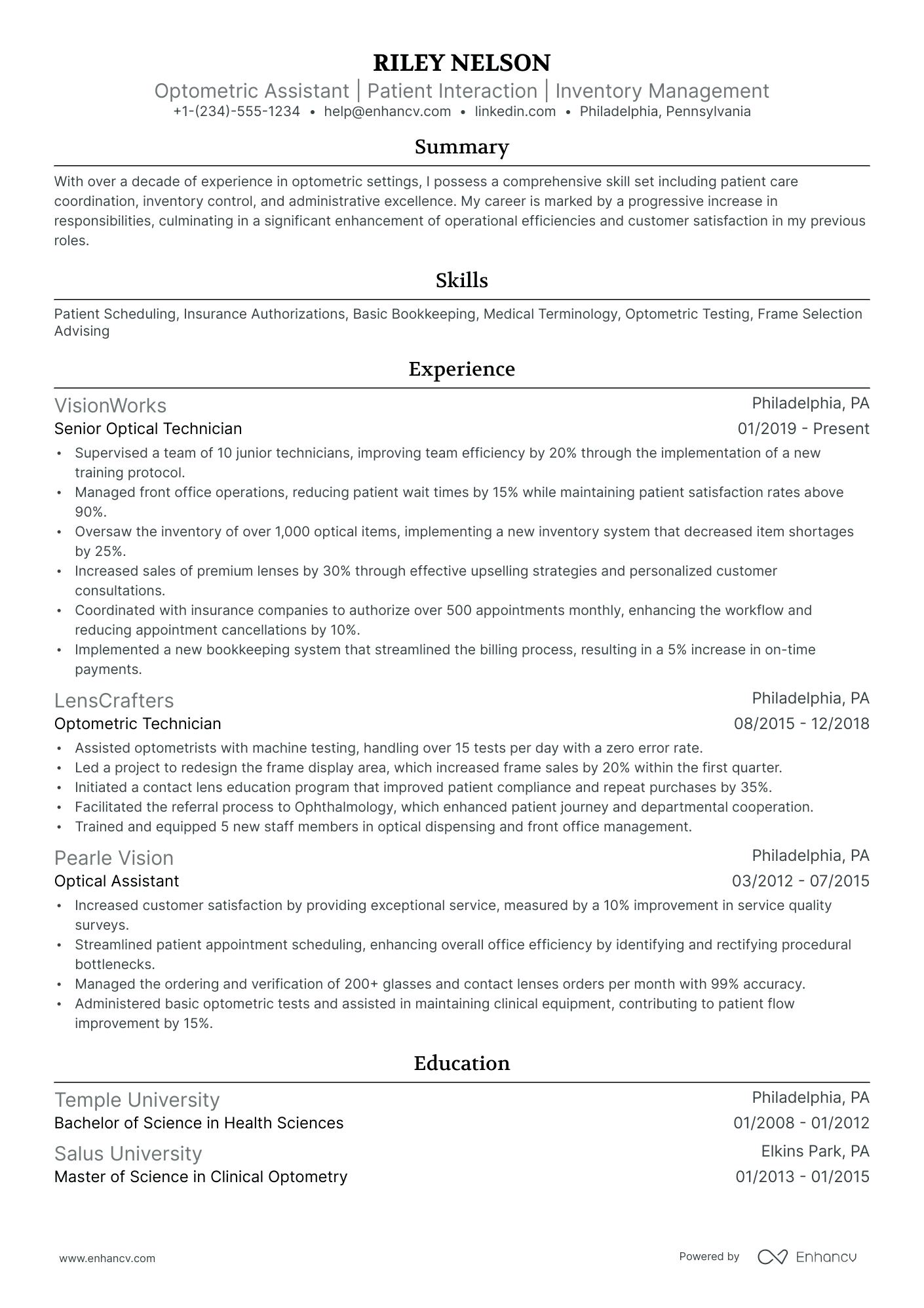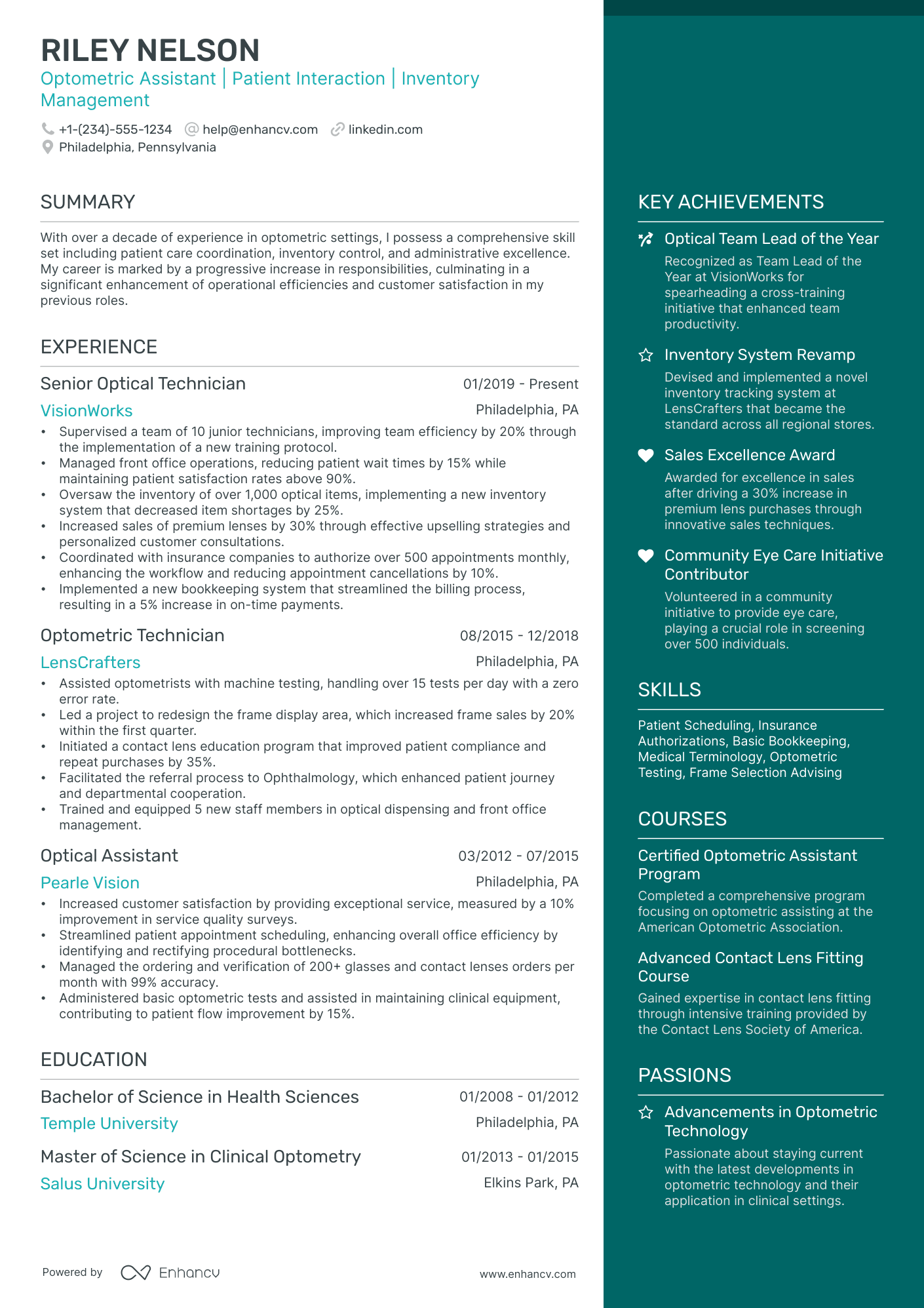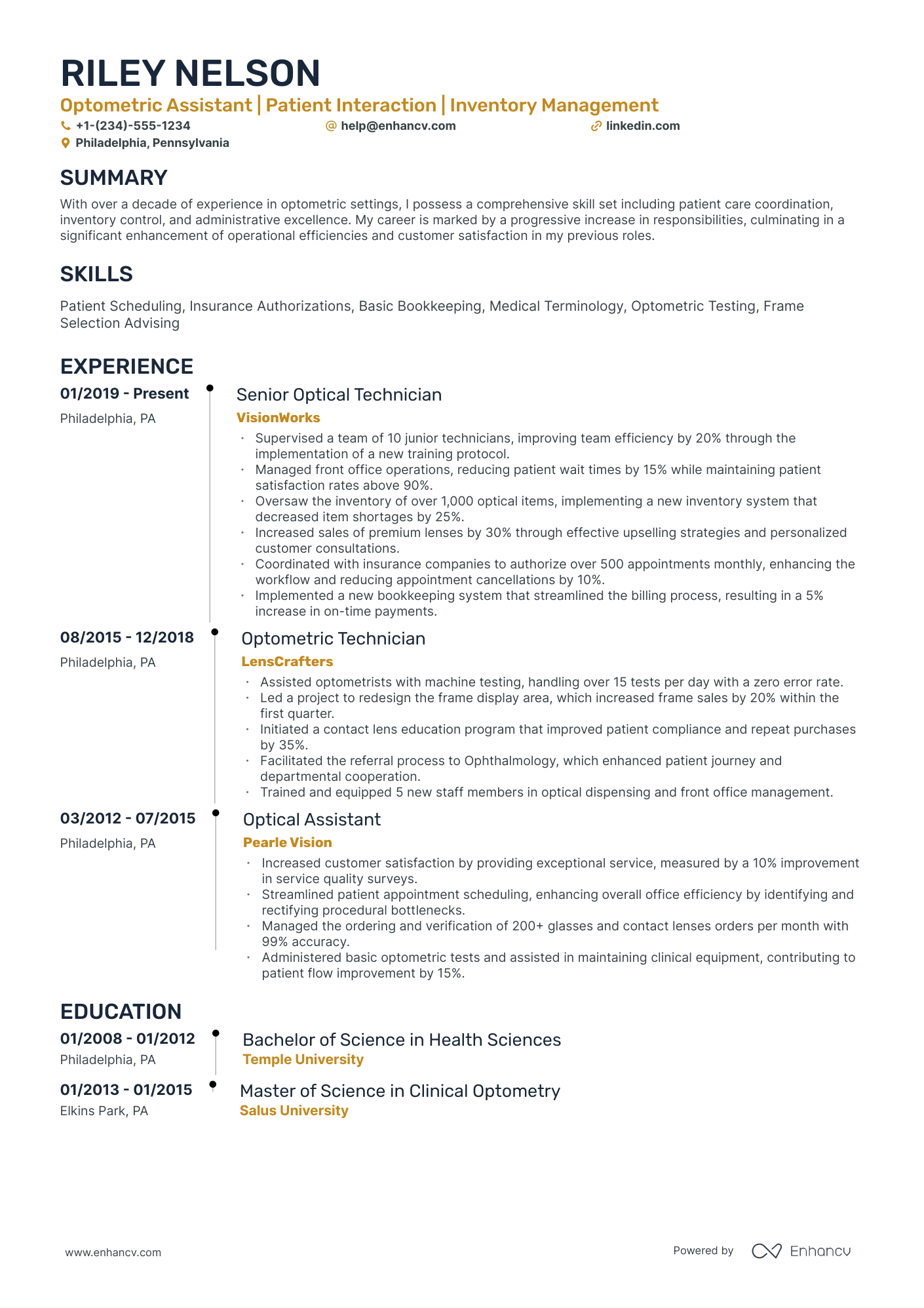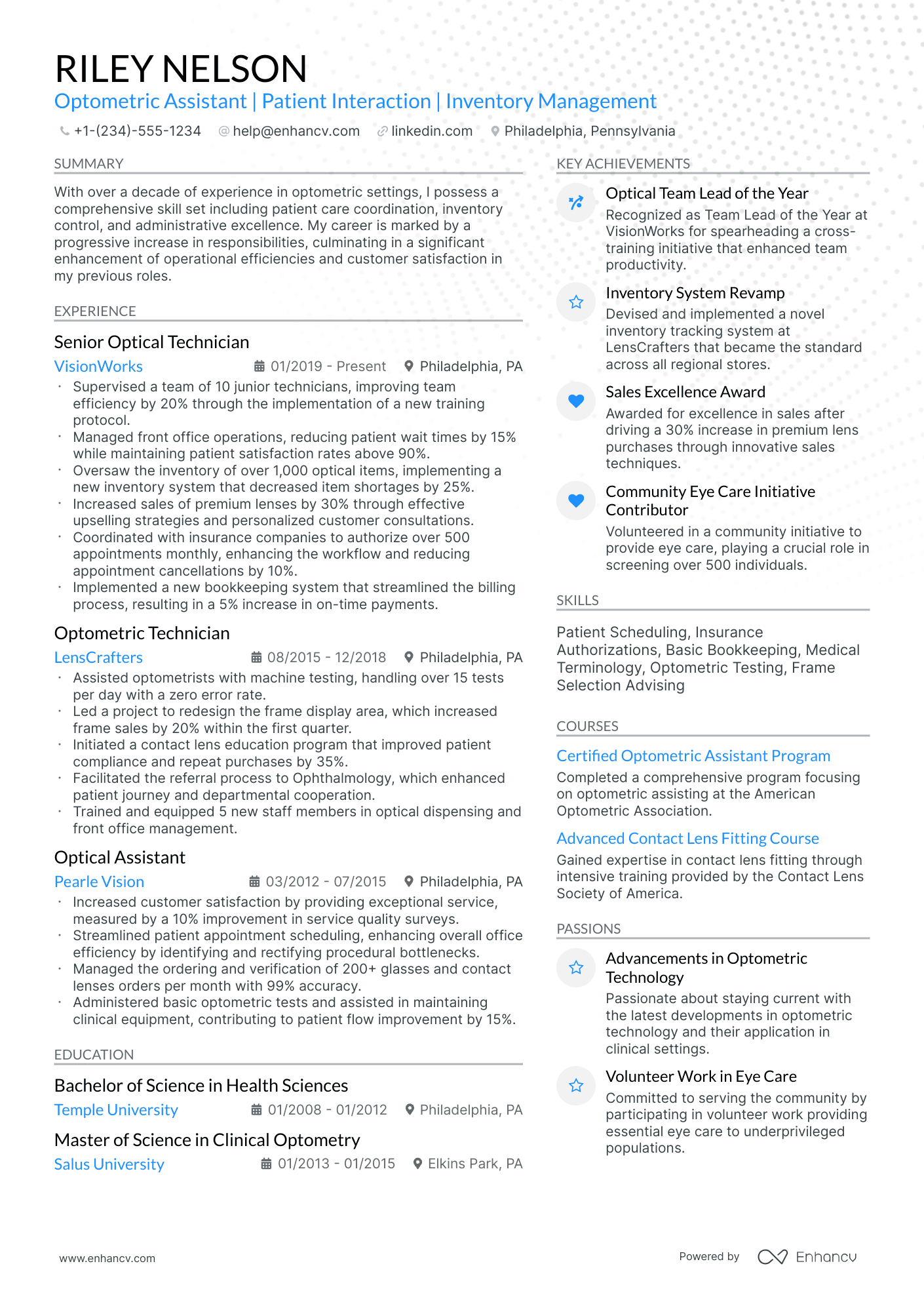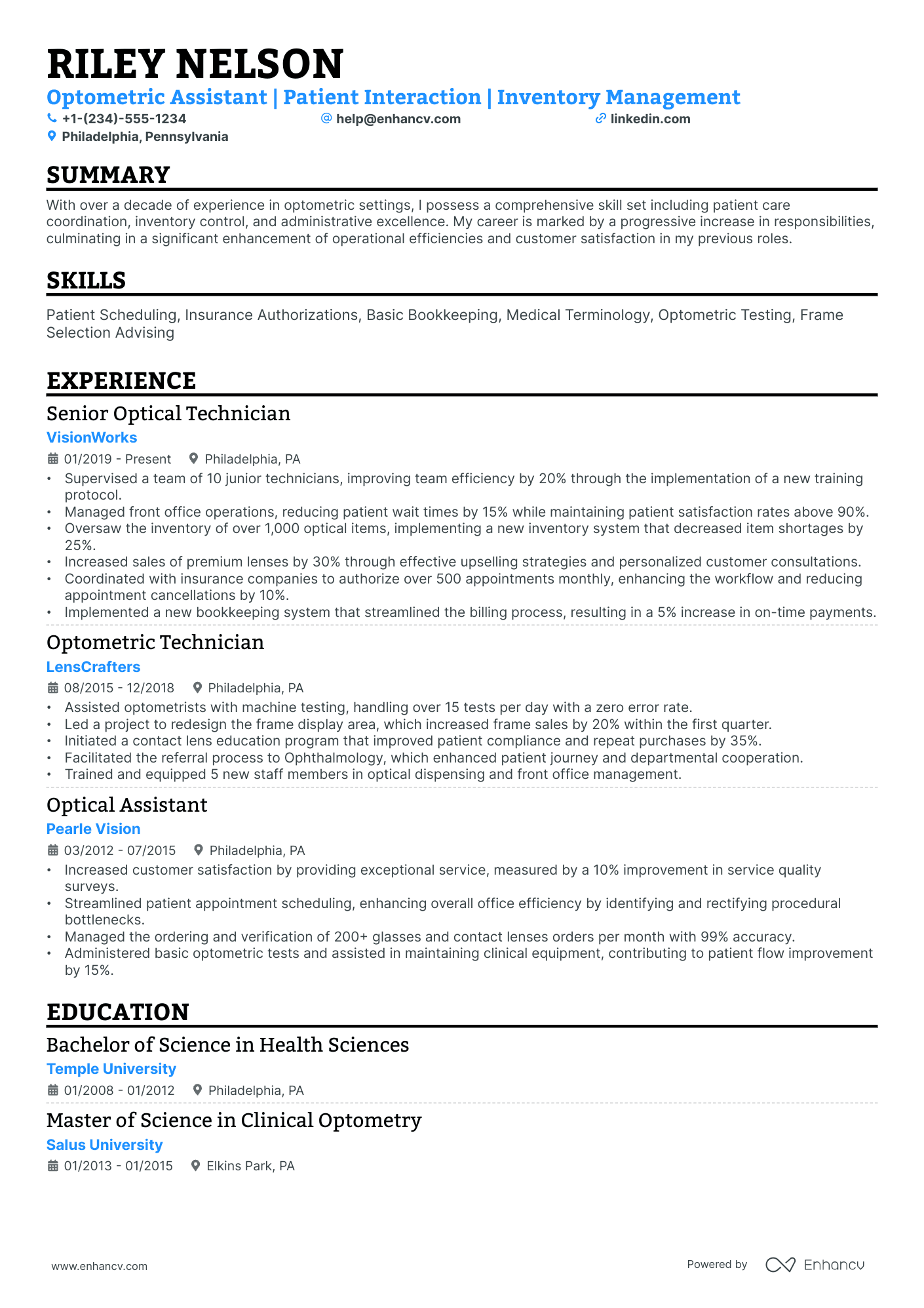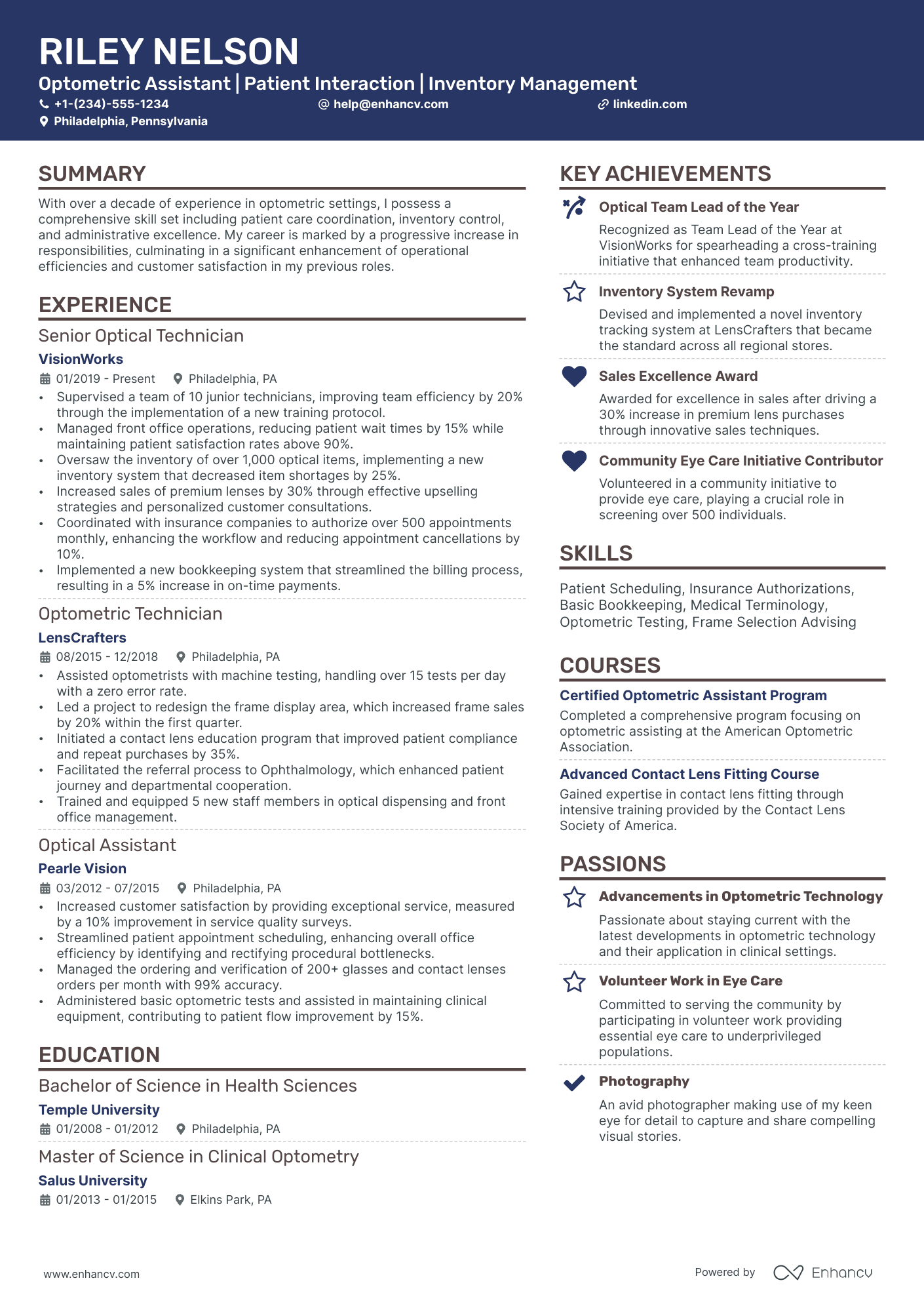Being an optometrist gives you a chance to improve how people see the world every day. What a rewarding reality! Beyond the sense of purpose, this career offers financial stability, high job satisfaction, and—drumroll—low divorce rates! Yes, optometry lets you help others and boosts your chances for a comfortable, happy life. Security, stability, and fulfillment are much-coveted job traits, which explains the high volume of candidates for positions in the field.
Competition’s got nothing on you with our comprehensive optometrist resume guide. Check it out to get a clearer picture of what sections to include to truly shine.
We’ve also provided tips on:
- How to format your resume clearly and elegantly to reflect the seriousness of the role.
- How to describe measurable outcomes that demonstrate your impact and expertise in the field.
- How to customize your resume to a real job posting—with real examples.
- Emphasizing certifications to stand out among specialists with similar academic degrees.
- Including additional sections that reflect your uniqueness.
- Showcasing your specific skill set and how it distinguishes you as a professional.
We’ve got plenty more nursing and healthcare resume and cover letter guides:
- Nurse Anesthetist Resume Example
- Life Coach Resume Example
- Retail Pharmacist Resume Example
- Practice Nurse Resume Example
- Physical Therapist Resume Example
- EMT Resume Example
- Clinical Nurse Resume Example
- Agency Nurse Resume Example
- Charge Nurse Resume Example
- Optometry Cover Letter Example
How to format an optometrist resume
As an optometrist, you’re aware that seeing things clearly is crucial. A well-organized resume format smoothly guides employers through your career and achievements with a logical layout. Let’s look at some key tips to help you stand out:
- Simplicity is king: You want your resume to present like an optometry office: clean and tidy, with everything you need within reach. Organize information neatly and present it with clear resume headers. Also, to make your document easily scannable, maintain a length of 1 to 2 pages.
- Choose the right design and fonts: Organize the information using a simple, elegant design and professional fonts, such as Rubik and Lato. Both serif and sans-serif fonts are compatible with ATS (Applicant Tracking Systems). ATS is the sieve your resume goes through before it gets to the recruiter.
- Work experience: Display your career trajectory by starting with your most recent experience and listing the rest in reverse chronological order. This will ensure the recruiter is up-to-date with your path in the field of optometry.
- Focus on your education and certifications: A strong educational background is a basis in the optometry field, and certifications give you credibility.
- Refine your skills section: Add all your relevant optometry skills, such as performing an eye exam, diagnosing diseases, and providing prescriptions. Don’t forget to include a variety of soft skills, such as communication and patience, generally needed for an optometry role.
- Header, contact info, and photo: Begin with a straightforward header featuring your name, professional title, and contact information. Skip the photo unless explicitly required. By doing this, you maintain the emphasis on your qualifications and professional traits.
- PDF format: Choose a PDF resume format to preserve the layout across various platforms. And don’t worry about PDF not being ATS-friendly, we’ve done the research and the majority of modern ATS systems read PDF perfectly fine.
Is your resume interview-ready? Try out our ATS Resume Scanner!
Keep in mind the market you’re applying to – a Canadian resume, for instance, might have a unique layout.
Here are some essential sections to include in your optometrist resume:
The top sections on an optometry resume:
- Personal information section: Include personal details like full name, contact information, and address. This will allow the recruiter to quickly identify and contact you.
- Objective statement: The objective should focus on what your optometrist experience can bring to the company. A compelling objective can capture the recruiter's attention.
- Education and certification: List your degree in optometry and any additional certifications. This will confirm you have the required formal training to work as an optometrist.
- Clinical experience: List your previous work experiences in the field of optometry, with a focus on duties and achievements. This is a vital section to demonstrate your practical experience in the industry.
- Skills and abilities: Present your professional skills relevant to an optometrist’s role like the ability to perform eye exams, diagnose diseases, and prescribe eyeglasses or contact lenses. This section highlights your capabilities to the recruiter.
Hiring managers will seek important details in each part of your resume, so customize the information you include appropriately.
What recruiters want to see on your resume:
- Board certification in optometry: This one is significant to recruiters as it affirms the optometrist's ability to adhere to professional standards and competence in diagnosing and treating eye conditions.
- Previous experience: It’s prioritized because it indicates how equipped you are to handle responsibilities, by demonstrating your familiarity with the role of optometry.
- Specialization: Certain fields within optometry like pediatric optometry or ocular disease can be highly valued. Having specialization denotes specific skills or knowledge that can benefit the employer's practice.
- Soft skills: Skills such as communication and empathy are important in optometry for gaining the patient's trust, explaining medical conditions, and providing treatment options.
- Continuing education: Recruiters value this as it shows an optometrist's commitment to staying updated with recent advancements in eye care treatment and technology. This makes you more adaptable in a changing medical landscape and proves your dedication to your profession.
Now that we’ve established the main sections your optometrist resume should include, let’s break them down. We’ll begin with the one you can’t go without—your experience.
How to write your optometrist resume experience
Knowledge put to practice is the optimal way to get ahead as an optometrist, and your resume work experience section should reflect that. Clearly outlined and quantifiable responsibilities will lead recruiters down the path of your work achievements.
For an optometrist resume, make sure you include only relevant experience to show you follow a consistent path in the sphere. Accentuate your abilities and accomplishments, such as working with modern technology or handling patients with a wide range of needs.
To better illustrate what we mean, let’s look at a real-life job posting:
Job Title: Optometrist
Company Introduction: At our practice, we believe that the optometrist is the hero of primary eye care, enabling and safeguarding their patient’s ability to experience his or her best vision. For many people, an optometrist is also the first point of contact into the healthcare system. The eyes can offer a window into overall health, and thus this first touch point can be critical for patients getting the care they need for serious conditions. We don’t take that responsibility lightly, which is why we empower our optometrists to provide the highest quality of care.
Job Description: Primary care is more than prescribing contacts and eyeglasses. Our optometrists report seeing a high amount of anterior and posterior segment pathology in their practices. They manage ocular disease to their comfort level, including but not limited to:
- Treating corneal ulcers and uveitis
- Red eye
- Diagnosing diabetic retinopathy and glaucoma
- Removal of foreign bodies
- Diagnosing macular disease, retinal holes and retinal detachments
Qualifications:
- Doctor of Optometry Degree (OD) from an Accredited School of Optometry
- State Licensed or will be licensed to practice Optometry (New Graduates) in the state in which you will be practicing.
Location: Schaumburg, IL (On-site)
Here’s an experience section that wouldn’t work:
- •Saw patients.
- •Performed eye exams.
- •Diagnosed conditions.
- •Prescribed glasses and contacts.
- •Collaborated with other professionals.
Why it doesn’t work:
- Vague description: The job description is too generic and doesn't highlight specific responsibilities or achievements. Simply stating, "Worked as an optometrist," lacks detail and doesn't convey the scope of the role.
- No emphasis on impact: The resume fails to highlight the impact of the optometrist's work. There are no quantifiable achievements or outcomes, such as patient satisfaction scores, number of successful treatments, or improvements in patient health.
- Lack of keywords: Important keywords and phrases from the job posting, such as "anterior and posterior segment pathology," "corneal ulcers," "uveitis," and "retinal detachments," are missing. These terms can help you pass through the ATS and catch the eye of hiring managers.
What a mess! While an application lacking specific experience can still be considered, it should at least refer to some of the qualifications needed based on the job description. Now let’s look at an improved example that considers the requirements of the job posting above:
- •Diagnosed and managed a variety of ocular conditions including diabetic retinopathy, glaucoma, and macular disease.
- •Performed treatments such as the removal of foreign bodies, treating corneal ulcers, and managing red eye and uveitis conditions.
- •Conducted routine eye exams while also educating patients on eye health and preventive care measures.
- •Collaborated with other healthcare professionals to provide integrated care that addresses the overall health of patients.
Now this one definitely makes the cut. It’s a well-constructed resume section that includes relevant experience, emphasizes applicable skills, and—most importantly—aligns well with the demands of the job posting. Here’s why it works:
- Right experience for the job: This candidate isn't new to the field—they’ve been working as an optometrist, directly linking their past work to what the job listing demands.
- Spot-on skills: They've got a list of skills that check all the right boxes for this position, like managing diabetic retinopathy and glaucoma, exactly what the job posting calls for.
- Perfect fit for the role: The resume shows they’re not just about eye exams. They’re about top-notch patient care and education, which is right up this company’s alley.
- Growth and dedication: The ongoing role with expanding responsibilities shows they’re committed and continually upping their game—a big plus for any employer.
PRO TIP
Boost your chances of getting that dream spot by tailoring your resume to the job posting. Focus on the skills and experiences that match what the employer is seeking. This shows you've done your homework and positions you as a strong fit for the role.
You can see how this example would catch a hiring manager’s eye. Now let’s see how to add measurable success to your resume.
How to quantify the impact on your resume
Adding specific numbers to your optometrist resume can make your expertise pop. Mentioning the percentage of patients with improved vision outcomes highlights your skills in routine and specialized treatments. These metrics clearly demonstrate how you stack up against other candidates. Here’s how to approach quantifiable results:
- Include specific numbers of patients you handled per week in your previous employment to illustrate efficiency and capability.
- State the number of vision exams conducted to show your practical experience and potential to contribute regularly.
- Highlight quantifiable improvements you've made, such as increasing patient satisfaction ratings by a certain percentage, to demonstrate a proactive approach to improving patient outcomes.
- Mention successful procedures you've participated in to display your competence in executing critical tasks of an optometrist.
- Document any significant increase in patient return rates in your previous position to emphasize your ability to build lasting relationships with patients based on trust and satisfaction.
- Indicate the scope of your reach by stating the number of patients you've provided eye care education to, showcasing your ability to extend vision care beyond the exam room.
- Specifically mention the percentage by which you’ve improved diagnosis accuracy, contributing to better health outcomes and displaying the impact of your skills on patients' health.
- Write about instances where you've helped reduce costs, such as optimizing supply procurement leading to a reduction in overheads, to emphasize your awareness of the business aspect of an optometrist's role.
We’ve tackled resume tips for seasoned pros, so let's dive into some strategies for those just starting out, like optometry students with minimal experience.
How do I write an optometrist resume with no experience
Practical experience in optometry is important but it’s not a make-or-break factor to land you a job. Here’s how to get closer to your dream position even if you have little to no experience:
- Job shadowing: Go to any clinic or optical nearby and ask the optometrist if you can shadow them for a while. Ask if they’re hiring or accepting volunteers. If not, you can always ask for connections. Most people would be happy to help.
- Work in related fields: Consider positions in related fields such as opticianry, vision care retail, or in a healthcare facility. These allow you to build relevant skills and make internal transitions easier later on.
- Attend workshops or seminars: Engaging in continuing education is a great way to stay updated about the latest research and technology in optometry. It’s also a great way to build relationships with professionals in the field.
- Join professional associations: Become a member of professional organizations like the American Optometric Association or other local optometric associations. Membership can provide access to resources, networking events, and professional development opportunities.
- Highlight internships or academic projects: Internships provide invaluable practical hands-on experience and networking opportunities.
- Demonstrate soft skills: Think of examples of situations where you used your communication, problem-solving, and interpersonal skills. These are paramount for dealing with patients effectively. Insert them in different sections of your resume, such as your experience and education.
- Mention transferable skills: Skills you’ve obtained in other positions can help you transition smoothly into the optometry field. Communication, attention to detail, and customer service all fit.
Next, let’s explore some key skills that will distinguish you as an outstanding candidate.
How to list your hard and soft skills on your resume
When creating an optometry resume, it's essential to include both hard and soft skills.
Hard skills are the technical abilities needed for the job, such as diagnosing eye conditions, using eye examination tools, understanding optical prescriptions, and handling relevant software.
Soft skills are the personal traits that affect your work dynamics. Important soft skills for optometrists include communication, empathy, problem-solving, and attention to detail.
Highlighting both types of skills gives a full view of what you can bring to the position. When you include them in your resume, be sure to:
- Accentuate your skills throughout: Think of ways to seamlessly incorporate relevant skills in different sections of your resume, like “skilled in ocular disease management”.
- Be specific and relevant: List the skills that are most relevant to the job you’re applying for, such as “Expert in retinal imaging” or “Effective communicator with patients and staff”.
- Use precise wording: Match the wording of your skills exactly to those listed in the job ad. For instance, if the ad specifies “pediatric optometrist,” list this skill as “pediatric optometrist” rather than “pediatric optometry.” Hiring managers and ATS will spot your qualifications more easily.
Consider including some of the following hard and soft skills:
Best hard skills for your optometrist resume
- Eye Examination
- Corrective Lenses Prescription
- Ocular Disease Diagnosis
- Contact Lens Fitting
- Glaucoma Detection
- Retinal Disease Management
- Pediatric optometry
- Ophthalmic Dispensing
- Visual Field Testing
- Low Vision Rehabilitation
- Binocular Vision Procedures
- OCT imaging
- Fluorescein Angiography
- Tonometry
- Refractometry
- Keratometry
- Ophthalmoscopy
- Orthoptics
- Optometric Corneal Topography
- Therapeutic Pharmaceutical Agents Application (TPA)
Best soft skills for your optometrist resume
- Communication
- Problem-Solving
- Patience
- Empathy
- Attention to Detail
- Decision Making
- Adaptability
- Interpersonal Skills
- Time Management
- Critical Thinking
- Teamwork
- Organizational Skills
- Leadership
- Initiative
- Reliability
- Negotiation
- Flexibility
- Creativity
- Stress Management
- Confidentiality
How to list your certifications and education on your resume
In the field of optometry, a science background and a relevant degree are standard requirements. Make your education section stand out by highlighting applicable academic experience or a top institution you’ve studied at. Distinguishing yourself with additional certifications can significantly enhance your resume.
- Recent certifications: Start with your latest certifications. Include specialty areas like pediatric optometry or glaucoma, listing the certifying body and the date received.
- Doctor of optometry degree: List your O.D. degree next, including the institution, location, and graduation year. Emphasize any prestigious honors or recognitions.
- Undergraduate education: Mention your bachelor’s degree, and the institution you graduated from, as this could contribute to your reputation and prestige. Highlight notable honors or recognitions.
- Professional memberships: State your memberships in organizations like the American Optometric Association, indicating the start year.
- Licensure: Clearly list where you’re licensed to practice, emphasizing multi-state licensure if applicable.
Here’s an example of a good education section:
- •Dean’s List for all semesters.
- •Relevant coursework: Clinical Optometry, Ocular Disease Management, Advanced Contact Lens Fitting.
- •Participated in a research project focused on innovative glaucoma treatments.
Why this entry works:
- Emphasizes academic excellence: The candidate’s outstanding academic performance is noted by the graduation Summa Cum Laude as well as the inclusion on the Dean’s List.
- Lists relevant skills: Includes coursework directly related to key optometry practices, guaranteeing strong foundational knowledge in the field.
- Practical experience: Highlights involvement in glaucoma research, indicating hands-on expertise and keeping up-to-date with industry advancements.
In the field of optometry, where formal education is a standard requirement, distinguishing yourself with additional qualifications can significantly enhance your resume. Consider including one of the following certifications.
Best certifications for your optometry resume
Now let’s move on to crafting a personal statement that will best reflect your career goals.
How to write your optometry resume summary or objective
Building an effective personal statement involves a clear grasp of your professional skills, responsibilities, and career goals. Place it at the top of your resume to immediately grasp recruiters’ attention. Choose between a summary and an objective depending on your individual career trajectory. Check below to see which one’s best for you.
Optimize your resume summary and objective for ATS
Drop your resume here or choose a file.
PDF & DOCX only. Max 2MB file size.
Resume summary
An optometry resume summary is perfect for those with significant experience in the field. It should distinctly outline your career progression, additional certifications, and interpersonal skills.
Resume objective
A resume objective is ideal if you’re an optometry student or a recent graduate. It should reflect your eagerness to gain practical experience as an optometrist.
Here’s an instance of a poorly written resume summary.
Why this is a bad example:
- Uses broad terms without specifying any particular skills or expertise.
- Lacks specific achievements.
- The statement “Seeking new positions” is too generic and doesn’t communicate the candidate’s career goals.
Let’s see an improved version:
Why is this example better:
- Highlights specific expertise, distinguishing the candidate.
- The professional and focused tone helps establish the candidate as serious and committed to their profession.
- Mentioning quantifiable achievements is a guarantee for effectiveness and impact in the optometry field.
Last but not least, let’s explore some additional sections you can include on your resume to make it really distinctive.
Additional sections for an optometry resume
optometry is a competitive field where most candidates start out with a similar educational background and basic qualifications. Additional sections can differentiate your resume and enhance your chances of being selected. Here are some instances that catch the eye:
- Research and publications: Participation in research or publications in academic journals are an appealing asset, especially for research-oriented positions.
- Volunteer work: Involvement in community service, especially related to healthcare or vision care, reflects your dedication to public service and patient care.
- Languages spoken: Proficiency in different languages is a strong point if you’re pursuing a career in a multinational environment. It’s also beneficial for working with diverse communities.
How to put a professional references section on your resume
Notable figures in optometry vouching for your skills and character can give you extra credibility. See how professional references can be presented in the example below. This format lists each reference's name, location, contact information, and relationship to you in a straightforward and easily readable way.
Key takeaways
The perfect job, as well as the perfect resume, is all a matter of perspective. Our optometry resume example guide can help you put your best foot forward in your job hunt.
Keep your eye on the following to impress hiring managers and excel in the optometry field:
- Clear and elegant formatting: Use a polished layout for your resume to demonstrate professionalism.
- Adapt to the position: Applying for a job in a competitive field such as optometry requires a resume that’s adjusted to the job posting.
- Quantify your success: Measurable results enhance your personal marketing. Data-driven achievements can be powerful negotiation tools.
- Education and certifications: In a sphere where everybody’s got a degree, be sure to enhance your resume with extra qualifications.
- Personalize: Be it professional recommendations or time dedicated to research, tell the story of your individual optometry path.
